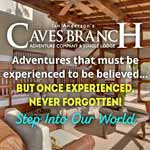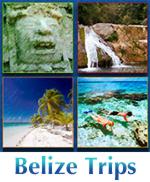El Pilar Archaeological Reserve for Maya Flora and Fauna
I. The El Pilar Archaeological Reserve for Maya Flora and Fauna
 Imagine how Frederick Catherwood and John Lloyd Stephens must have felt upon seeing the vine wrapped, overgrown, abandoned cities and temples of the ancient Maya in their expeditions of the 1830s and 40s. Re-discovered only 25 years ago, the unique Maya site El Pilar on the border of Guatemala and Belize offers that same experience: the monuments are still embraced by the forest, showcasing the Maya foliage as much as the Maya city itself. The style of presentation practiced at El Pilar is called "Archaeology Under the Canopy," where the ancient monuments are protected by the forest that envelops them.
Imagine how Frederick Catherwood and John Lloyd Stephens must have felt upon seeing the vine wrapped, overgrown, abandoned cities and temples of the ancient Maya in their expeditions of the 1830s and 40s. Re-discovered only 25 years ago, the unique Maya site El Pilar on the border of Guatemala and Belize offers that same experience: the monuments are still embraced by the forest, showcasing the Maya foliage as much as the Maya city itself. The style of presentation practiced at El Pilar is called "Archaeology Under the Canopy," where the ancient monuments are protected by the forest that envelops them.
The natural environment is further featured with an active forest garden, emphasizing Maya life ways and management of the Maya Forest - practices that made possible the extraordinary development of the great Maya civilization. The monuments tell the story of a complex center whose history spanned 2,000 years, as well as reveals ancient agricultural practices that promoted the forest and wildlife while supporting a large human population. These features of El Pilar yield potential answers for creating a sustainable future.
Perhaps most importantly, El Pilar today is a symbol of collaboration across political, economic, and cultural boundaries. Protected today in Guatemala and Belize, El Pilar's temples and plazas are connected by an ancient Maya causeway, symbolizing its potential to become the world's first archeological peace
park. Fostering confidence and building common ground, the Mesa Redonda El Pilar process initiated in 1996 has paved the way for support of one resource in two countries. This is the El Pilar Peace Park Initiative.
II. Ancient History of El Pilar
 El Pilar flourished as a Maya garden city for nearly 2,000 years. It was the largest urban area in what is now the edge of greater Pet�n. At its peak it housed more than 20,000 people in a mosaic landscape of city houses and gardens, surrounded by forest and agricultural fields. The city had what is rare in the Maya area, an abundance of water: the name "El Pilar" is derived from the Spanish word for watering basin. The venerable Tikal, 30 miles (50 km) to the west, had no naturally occurring water sources.
El Pilar flourished as a Maya garden city for nearly 2,000 years. It was the largest urban area in what is now the edge of greater Pet�n. At its peak it housed more than 20,000 people in a mosaic landscape of city houses and gardens, surrounded by forest and agricultural fields. The city had what is rare in the Maya area, an abundance of water: the name "El Pilar" is derived from the Spanish word for watering basin. The venerable Tikal, 30 miles (50 km) to the west, had no naturally occurring water sources.
Through ceramic analysis, archaeologists have determined that major construction at El Pilar began around 800 BCE, in what is known as the Middle Preclassic Period. These early monuments relate to the early growth of settlements in the Belize River Area and predate those of Tikal, only a two-day walk from El Pilar. Concurrently, the Olmec of the Gulf Coast of Mexico were flourishing and the large center of El Mirador was on the rise. This growth would later spread into the core area, foreshadowing the preeminence of Tikal.
In the Late Preclassic Period, beginning 250 BCE, major public centers were known in the entire region from the interior of the Pet�n to northern Belize. Populations were growing, settlements were fully established, and the path to civilization was underway. At El Pilar the major plazas had been defined and established. This is noted particularly with the formation of the large expanse of Plaza Copal, the first construction of the ball court, and the "E" group thought to be astronomically oriented.
 By 250 CE in the Early Classic Period there were major public works and a significant population around El Pilar. This period saw the start of the tradition of magnificent carved stela commemorating regal events of succession, marriage, and conquest. Population was expanding but would not reach its height until the Late Classic period. El Pilar's dominance in the local area is evident; El Pilar is only 10km northwest of the Belize River and the numerous minor centers that interacted at the edge of greater Pet�n into the core area of the magnificent city center Naranjo, about 20 km to the southeast.
By 250 CE in the Early Classic Period there were major public works and a significant population around El Pilar. This period saw the start of the tradition of magnificent carved stela commemorating regal events of succession, marriage, and conquest. Population was expanding but would not reach its height until the Late Classic period. El Pilar's dominance in the local area is evident; El Pilar is only 10km northwest of the Belize River and the numerous minor centers that interacted at the edge of greater Pet�n into the core area of the magnificent city center Naranjo, about 20 km to the southeast.
The Late Classic from 600-900 CE marks the pinnacle of the Maya civilization, witness to some of the greatest cities and largest populations. El Pilar was the largest civic center of the area, with more than 25 identified plazas in an area of about 100 acres (38 hectares). It is composed of three main sectors named Xaman, Nohol, and Poniente. Two ball courts are found in the Nohol and Poniente sectors that are connected with a causeway. Both of these areas boast broad open plazas. The H'mena acropolis is secluded in the northern Xaman sector. The tallest buildings are 17-20 meters high, offering spectacular vistas of the Maya Forest.
Monumental construction continued at El Pilar with the last major remodeling completed in the Terminal Classic Period (1000 CE). This is a time when formerly important centers, such as Tikal, were in their decline.
This long sequence testifies to continuous and methodical development in the area. After almost two thousand years of occupation, the monuments at El Pilar were left unattended approximately 1000 years ago, but the Maya forest was never abandoned.
III. Rediscovery and Research

El Pilar was unexplored by Western archeologists until 1983. When Anabel Ford began her work as an archaeologist in the Maya forest in 1972, she was interested in the everyday life of the Maya through the study of cultural ecology-the relationships of humans and their environment. While conducting a settlement survey in the forested ridge lands, she re-discovered El Pilar, a Maya urban center with major temples and plazas extending across more than 50 hectares (about 100 acres). At that time locals were using the land for casual agricultural pursuits. Ford was privileged to be the first to map the extent of the site, chart the size and scope of the ancient center, and literally put El Pilar on the map. This began her research spanning more than three decades in and around the site.
In the 1980s Ford launched the Belize River Archaeological Settlement Survey, known as the BRASS project that has emphasized the ancient Maya people rather than the governing elites. Multidisciplinary studies focus on where the Maya built their homes (settlement patterns) and how they fed their large populations (resource management). Archaeology Under the Canopy and the Maya forest garden are important elements of these studies. They may seem disconnected, but in reality they are the thread connecting the past to the present and future as researchers unravel the mysteries of the ancient Maya. In practicing their traditional life ways, the contemporary Maya inform the past, telling us about life around El Pilar at its height. Combining research and development, the project conducts major excavations of temples and plazas while promoting community involvement and tourism.
Excavation continues with survey work in the three main sectors of El Pilar: Xaman, Nohol, and Poniente. An ancient Maya house site uncovered in 1996, Tzunu'un, provides a window into domestic Maya life. An active forest garden surrounds the house plaza to create a living environment.
IV. Visit El Pilar
 El Pilar Archeological Reserve for Maya Flora and Fauna is a place of imagination that welcomes adventurers, scholars, and conservationists all year round. Today the site is a registered Cultural Monument in both Belize and Guatemala, established as a contiguous 2,000 hectare (5,000-acre) archaeological reserve. Seven culture and nature trails wind through the ancient monuments of El Pilar. Modern infrastructure includes a ranger's house, eight comfort stations, a large picnic area, many thatched overlooks, and signage.
El Pilar Archeological Reserve for Maya Flora and Fauna is a place of imagination that welcomes adventurers, scholars, and conservationists all year round. Today the site is a registered Cultural Monument in both Belize and Guatemala, established as a contiguous 2,000 hectare (5,000-acre) archaeological reserve. Seven culture and nature trails wind through the ancient monuments of El Pilar. Modern infrastructure includes a ranger's house, eight comfort stations, a large picnic area, many thatched overlooks, and signage.
Accessed from San Ignacio, Belize, you approach the site through Bullet Tree Falls and go seven miles (11 km) north to the ridge of the reserve. There is a nominal entrance fee and tickets can be purchased from the ranger's station at the site or at the central ticketing museum at the Cahal Pech site in San Ignacio, Belize. In addition to the features of Archaeology Under the Canopy and the Maya forest garden, the reserve offers great hiking, bird watching, wildlife, and the annual May event, the Fiesta El Pilar.
From Melchor, Guatemala Access to El Pilar is improving based on the road to Laguna Yaloch, north of El Pilar. With archaeologists now working at the site, caretakers are present, but road signs are scarce. The drive is approximately 30 kilometers on an all-weather dirt road, used in the dry season for trucking lumber (watch out!). It will be difficult to drive in the rainy season. It is best to take a guide to know the cutoff to the east in a beautiful corozo palm forest.
From Cayo, Belize El Pilar is approximately 11 kilometers northwest of the village Bullet Tree Falls, just outside the town of San Ignacio. An official Institute of Archaeology "El Pilar" sign in Bullet Tree marks the all-weather dirt road that leads north to the site. You can arrive at the site by tour, taxi, rented car, mountain bike, horse, or foot. The road is uphill and largely unshaded, so bring plenty of water regardless of transport. A taxi from Bullet Tree should cost about US$30 to and from the site. The driver will wait as you explore. By car, the trip is about 30 minutes from Bullet Tree. You can rent mountain bikes or horses from places in Bullet Tree or San Ignacio.
For more information about El Pilar, Archaeology Under the Canopy, Maya forest gardening, and the El Pilar Peace Park Initiative, see:
www.espmaya.org, www.marc.ucsb.edu, www.mayaforestgardeners.org
Pictures: BRASS/El Pilar Project, Macduff Everton, Michael Glassow.
Guatemala Times


 Imagine how Frederick Catherwood and John Lloyd Stephens must have felt upon seeing the vine wrapped, overgrown, abandoned cities and temples of the ancient Maya in their expeditions of the 1830s and 40s. Re-discovered only 25 years ago, the unique Maya site El Pilar on the border of Guatemala and Belize offers that same experience: the monuments are still embraced by the forest, showcasing the Maya foliage as much as the Maya city itself. The style of presentation practiced at El Pilar is called "Archaeology Under the Canopy," where the ancient monuments are protected by the forest that envelops them.
Imagine how Frederick Catherwood and John Lloyd Stephens must have felt upon seeing the vine wrapped, overgrown, abandoned cities and temples of the ancient Maya in their expeditions of the 1830s and 40s. Re-discovered only 25 years ago, the unique Maya site El Pilar on the border of Guatemala and Belize offers that same experience: the monuments are still embraced by the forest, showcasing the Maya foliage as much as the Maya city itself. The style of presentation practiced at El Pilar is called "Archaeology Under the Canopy," where the ancient monuments are protected by the forest that envelops them. El Pilar flourished as a Maya garden city for nearly 2,000 years. It was the largest urban area in what is now the edge of greater Pet�n. At its peak it housed more than 20,000 people in a mosaic landscape of city houses and gardens, surrounded by forest and agricultural fields. The city had what is rare in the Maya area, an abundance of water: the name "El Pilar" is derived from the Spanish word for watering basin. The venerable Tikal, 30 miles (50 km) to the west, had no naturally occurring water sources.
El Pilar flourished as a Maya garden city for nearly 2,000 years. It was the largest urban area in what is now the edge of greater Pet�n. At its peak it housed more than 20,000 people in a mosaic landscape of city houses and gardens, surrounded by forest and agricultural fields. The city had what is rare in the Maya area, an abundance of water: the name "El Pilar" is derived from the Spanish word for watering basin. The venerable Tikal, 30 miles (50 km) to the west, had no naturally occurring water sources. By 250 CE in the Early Classic Period there were major public works and a significant population around El Pilar. This period saw the start of the tradition of magnificent carved stela commemorating regal events of succession, marriage, and conquest. Population was expanding but would not reach its height until the Late Classic period. El Pilar's dominance in the local area is evident; El Pilar is only 10km northwest of the Belize River and the numerous minor centers that interacted at the edge of greater Pet�n into the core area of the magnificent city center Naranjo, about 20 km to the southeast.
By 250 CE in the Early Classic Period there were major public works and a significant population around El Pilar. This period saw the start of the tradition of magnificent carved stela commemorating regal events of succession, marriage, and conquest. Population was expanding but would not reach its height until the Late Classic period. El Pilar's dominance in the local area is evident; El Pilar is only 10km northwest of the Belize River and the numerous minor centers that interacted at the edge of greater Pet�n into the core area of the magnificent city center Naranjo, about 20 km to the southeast.
 El Pilar Archeological Reserve for Maya Flora and Fauna is a place of imagination that welcomes adventurers, scholars, and conservationists all year round. Today the site is a registered Cultural Monument in both Belize and Guatemala, established as a contiguous 2,000 hectare (5,000-acre) archaeological reserve. Seven culture and nature trails wind through the ancient monuments of El Pilar. Modern infrastructure includes a ranger's house, eight comfort stations, a large picnic area, many thatched overlooks, and signage.
El Pilar Archeological Reserve for Maya Flora and Fauna is a place of imagination that welcomes adventurers, scholars, and conservationists all year round. Today the site is a registered Cultural Monument in both Belize and Guatemala, established as a contiguous 2,000 hectare (5,000-acre) archaeological reserve. Seven culture and nature trails wind through the ancient monuments of El Pilar. Modern infrastructure includes a ranger's house, eight comfort stations, a large picnic area, many thatched overlooks, and signage.













